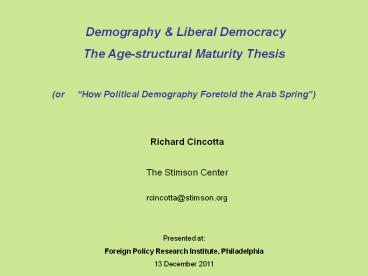Presented at: - PowerPoint PPT Presentation
1 / 25
Title:
Presented at:
Description:
Title: PowerPoint Presentation Last modified by: IT Team Created Date: 1/1/1601 12:00:00 AM Document presentation format: On-screen Show Other titles – PowerPoint PPT presentation
Number of Views:112
Avg rating:3.0/5.0
Title: Presented at:
1
Demography Liberal Democracy The
Age-structural Maturity Thesis (or How
Political Demography Foretold the Arab Spring)
Richard Cincotta The Stimson Center rcincotta_at_s
timson.org
Presented at Foreign Policy Research
Institute, Philadelphia 13 December 2011
2
The Demographic Transition
Cincotta Hummel, 2009
3
Age structural Classes Japan 1935 to 2025.
(Population)
(69.2 million)
(104.4 million)
(123.2 million)
(120.8 million)
Cincotta, in press
4
Four categories four individual countries, 2010
DATA SOURCE UN Population Division, 2011
5
Transitional Population age structures 2010
Data UN Population Division, 2009
6
The Empirical Narrative
Youthful
Intermediate
Mature
Post-Mature
Likelihood
15
25
35
45
55
Median Age (Years)
7
The Theoretical Narrative
Youthful
Intermediate
Mature
Post-Mature
Unconstrained executive power
Net Benefits
Civil liberties political rights
15
25
35
45
55
Median Age (Years)
8
Age structure Freedom Scores
1975 to 2005
Age structure (median age)
Y Youthful (lt25.0 yrs) I Intermediate
(25.1-35.0) M Mature (35.1 to 45.0) P
Post-mature (gt45.1) (no states yet within
this category as of 2010)
9
Proportion () Free
50-50 chance of Free
10
Youthfulness and the path to liberal democracy 8
selected states
Some anecdotal evidence of rises in democracy
scores as age-structural youthfulness declines.
Cincotta, 2009
11
Why does this model work?
Fate of States rising to liberal democracy during
the decade
1980s
Durability of Regime
No. of States
lt0.42
lt29 years
gt29 years
gt.42
Youth Proportion
Median Age
12
Youthful states
Data UN 2010 Rev.
13
from Barnett, 2004
14
Youthful states
Data UN 2010 Rev.
15
Youthful states
Data UN 2010 Rev.
16
Youthful states
Data UN 2010 Rev.
17
Youthful states
Data UN 2010 Rev.
18
Youthful states
Data UN 2010 Rev.
19
The Intelligence Value of Age Structure
Richard Cincotta Demographer-in-residence The
Stimson Center rcincotta_at_stimson.org
Presented at Foreign Policy Research
Institute, Philadelphia 13 December 2011
20
Year (5-yr period)
21
Data UN Population Div., 2010 Rev.
22
Age structure and the naïve probability of
liberal democracy
Model results forecasts Cincotta,
unpublished Population data UN Population
Division, 2010 Rev.
23
Proportion of states experiencing civil conflict
Conflict involves a more youthful minority
24
2008 Forecast
The first (and perhaps most surprising) region
that promises a shift to liberal democracy is a
cluster along Africas Mediterranean coast
Morocco, Algeria, Tunisia, Libya, and Egypt, none
of which has experienced liberal democracy in the
recent past. The other is in South America
Ecuador, Colombia, and Venezuela, each of which
attained liberal democracy demographically
early but was unable to sustain it.
Interpreting these forecasts conservatively, we
can expect there will be one, maybe two, in each
group that will become stable liberal democracies
by 2020.
Cincotta, R.P. 2008. How Democracies Grow Up.
Foreign Policy March/April, 80-82 (plus
supplementary map and graph online). Cincotta,
R.P. 2008/09. Half a Chance Youth Bulges and
Transitions to Liberal Democracy, Environmental
Change and Security Project Report, 13 10-18.
Available at http//www.wilsoncenter.org/topics/p
ubs/ECSPReport13_Cincotta.pdf These predictions
are the subject of the presentation on C-Span
http//www.c-spanvideo.org/richardcincotta
25
Low probability, High Impact Analysis, LRAU, Oct.
2010.
- Rapid democratization in North Africa and the
Rise of Islamic Parties. One component of
youth-bulge theory is a model that suggests
that the probability of attaining a stable
liberal democracy increases as a states age
structure matures. North African countries are
rapidly maturing toward the 50-50 break-even
point (a half a chance for a liberal democracy).
In this scenario, a North African state, probably
Tunisia, undergoes a color revolutiona swift
and non-violent transition to liberal democracy.
This may bring Islamists into poweror maybe not.
However, the possibilities for spreading
democracy through the region and for new
political dynamics to play out in an
age-structurally mature Arab state could produce
both risks and opportunities for the US. - Rationale Age-structural maturation liberal
democracy. Declines in the proportion of young
adults in the working age population tends to
make youth recruitment to political violence more
difficult and promote a more manageable political
environment. As politics lose their volatility,
commercial and military elites see opportunities
under democratic rule and a marketplace free of
the patron-client relationships supported by the
autocrat.
Product of political demographic
research. Submitted by R.P. Cincotta, Oct. 2010































